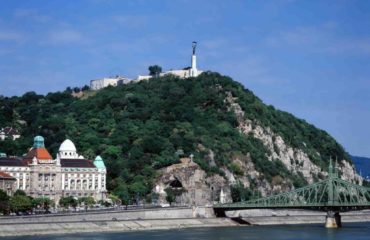The Hungarian Liberty Statue
What is it like?
 Nowadays, you can see a lady made from bronze who is holding a palm branch in her elevated hands. Her hair and dress seem to be blown by the wind which makes the statue quite dynamic. Originally, the monument contained more figures. Its first aim was to greet the Soviet Army after the 2nd world war in 1947 and to say thank to them for ’liberating’ the country from the Nazis. Consequently, there were two huge figures of soldiers and two other, symbolic items (one of them held a torch and the other one killed a dragon). After the fail of the Communist regime, side-figures of soldiers were removed. However, they weren’t destroyed; you can see them in the Statue Park of the city. All emblems of the regime were also removed, and the inscription has changed, too. It says thank to every people who devoted their lives to the prosperity and freedom of Hungary.
Nowadays, you can see a lady made from bronze who is holding a palm branch in her elevated hands. Her hair and dress seem to be blown by the wind which makes the statue quite dynamic. Originally, the monument contained more figures. Its first aim was to greet the Soviet Army after the 2nd world war in 1947 and to say thank to them for ’liberating’ the country from the Nazis. Consequently, there were two huge figures of soldiers and two other, symbolic items (one of them held a torch and the other one killed a dragon). After the fail of the Communist regime, side-figures of soldiers were removed. However, they weren’t destroyed; you can see them in the Statue Park of the city. All emblems of the regime were also removed, and the inscription has changed, too. It says thank to every people who devoted their lives to the prosperity and freedom of Hungary.
The Hungarian Liberty Statue
Who was the model?
Erzsébet Gaál was a young woman from the countryside who came to Budapest at that time. During his walk, Kisfaludy-Stróbl noticed her in a tram station, and he immediately knew that she would be his model. „I felt that pure fire in no one else, just in she”, wrote the sculptor later. „Soldiers died to make the life better for women like you, so I’d like you the model of my thanksgiving statue” – he told to Erzsébet, according to the woman’s memorandum.
At first, Erzsébet was frightened, but then she accepted the role of the model. It was a truly hard task! At every turn, she had to stand motionless for 20 minutes in a very uncomfortable position while a ventilator blew her clothes and hair. The artist demanded another sacrifice: Erzsébet had to cut down her wonderful long hair because it was much longer than Kisfaludy-Stróbl dreamed it. Moreover, she didn’t get a single penny for her work, as the propaganda said: she did it just for her honest love of her nation. Erzsébet wasn’t even been invited to the inauguration of the sculpture. In her civil life, she worked as an X-ray assistant in Sopron.
It’s extremely huge!
The designing of the statue was controlled by Vorosilov marshal who was the leader of the Soviet Army which invaded Hungary. Leaders of the country wanted to locate it in the garden of the Castle but Vorosilov had another idea. According to his command, the sculpture had to be on the Gellért Hill from which it could be well-seen in the whole inner city. The statue had to be higher than the Gellért monument at the foot of the hill. The whole masterpiece including the column is 40 m high from which the figure of the lady is 14 m.
Other sights on the Gellért Hill Budapest
We also recommend seeing the Citadel Budapest. This fortress was built after the fail of the Hungarian war for freedom in 1848/49. From it, soldiers of the Habsburg emperor could keep the inhabitants of the city under control. Despite its not too happy history, it’s a beloved aim of tourists. There are an exhibition and a restaurant in the building, and if you pass it a little upwards, you can enjoy the best view of the Danube and the city.
At the foot of the hill, it’s worth visiting the Gellért Baths. In the deep, there are several thermal springs which supply the pools. The water which contains calcium, magnesia, bicarbonate, chloride, and sulfate ions can help if you suffer from degenerative diseases of joints, disturbances of circulation, or bronchitis.
The building itself is wonderful; it was built in the style of the Art Noveau as well as the hotel which belongs to the bath. Great celebrations such as the Dutch queen or Menuhin were guests here.
You should also see the statue of Gellért for whom the hill received its name. He was a martyr priest in the first part of the 11th century. If you are interested in sculptures, you’ll love the Garden of Philosophers where there are the statues of the most significant characters and leaders of the main religions of the world.





